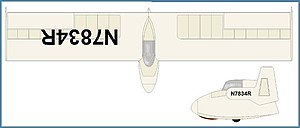Backstrom EPB-1 Flying Plank
| Backstrom EPB-1 Flying Plank | |
|---|---|

|
|
| Type: | Glider |
| Design country: | |
| Manufacturer: | |
| First flight: |
1957 |
| Production time: |
from 1957 |
| Number of pieces: |
> 16 |
The EPB1 board was designed in 1954 by the Easly / Powell / Backstrom trio to meet the need for a small, very simple sailor for home builders. The empty weight is around 65 kg. With a load of 90 kg and a sash area of 11.5 m², this results in a surface load of 13.5 kg / m². The span is 7.62 m, so that the wing can be built in one piece in the garage. The profile is from Georges Abrial and has a thickness of 15%.
The original version had a two-spar, fully clad wing and end disc rudder, on the outside of which expansion flaps were installed. A teardrop-shaped canopy sat on the fuselage.
For the construction plan version EPB1a, a partially covered wing with larger end disk side rudders and rudder airbrakes was introduced. The fuselage now ran out into a vertical ledge behind the cabin.
Mississippi State University developed a version of the original EPB1 that completely dispensed with vertical stabilization surfaces. Now spreading flaps took over the function of the rudder and the landing aid as an extension of the elevons. These only opened up on one side.
On one machine (N19C), its builder Al Cleave replaced the end disc rudder with a central rudder. This is also the only variant with landing aids. The flight characteristics of the machine now called EPB1c were therefore quite good, and the performance for such a tiny aircraft was quite satisfactory. The EPB1c is controlled via elevons and rudder. Small spoilers on the inner wing were available as landing aids.
In Australia, the two-seater Todthunter Twin Plank was created in collaboration with Al Backstrom.
The last motorless board from Al Backstrom's workshop was the EPB-1HR, known as the "Superplank", with the NACA 8-H-12 profile. Unfortunately, the profile did not turn out to be the best choice for a board only wing, although it did well on the slightly swept Brochocki BKB-1 . The superplank had elevons and splay brake flaps near the wing tips. The span was 9.15 m. The spreading flaps opened on both sides in this version. This was followed in 1975 by the WBP1 motor glider.
literature
- Rudolf Storck among others: Flying Wings. The historical development of the world's tailless and flying wing aircraft. Bernard and Graefe, Bonn 2003, ISBN 3-7637-6242-6 .
